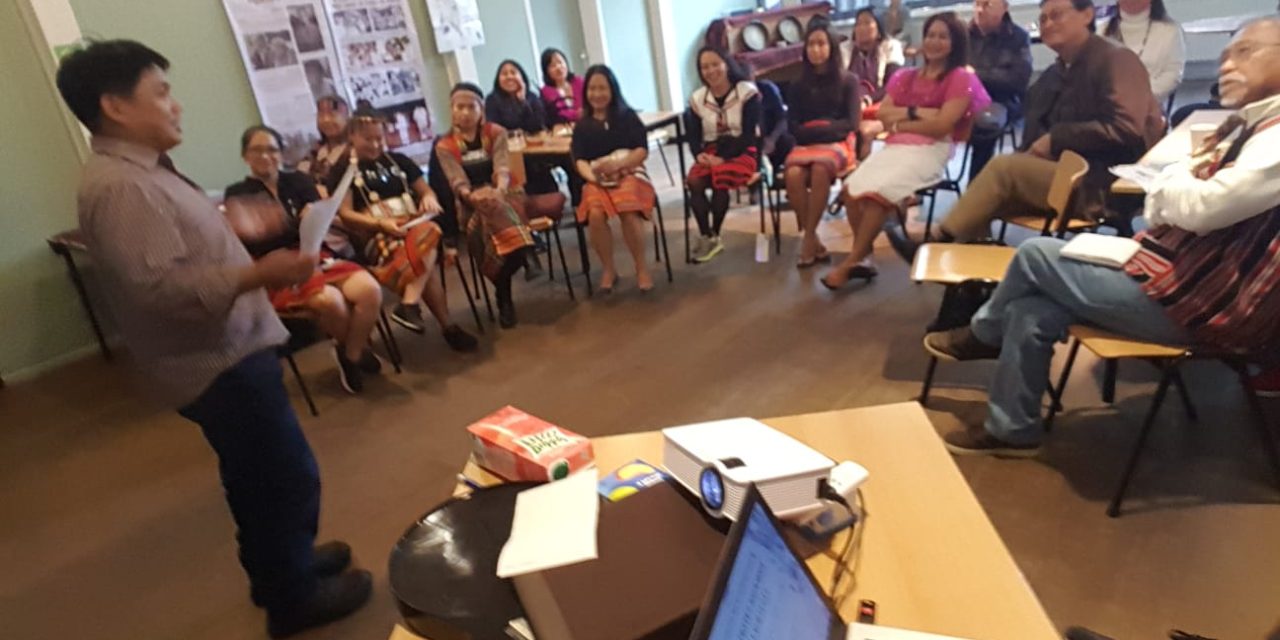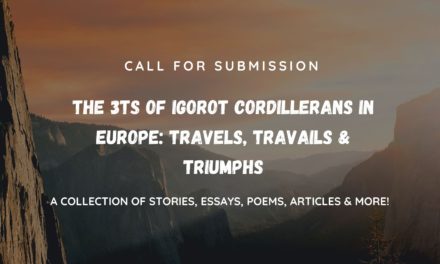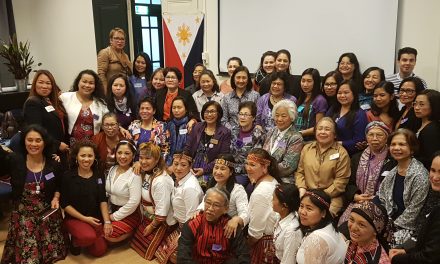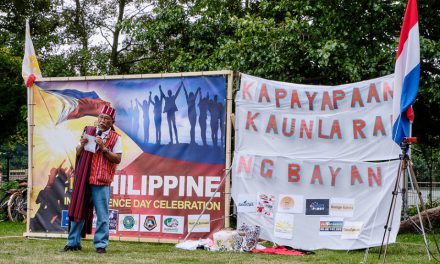By Andrei Angnged
I am honored to be invited and to be an active participant in this annual Indigenous Peoples Day and Workshop organized by MABIKAS Foundation. I would first like to all the Cordilleran’s present here if they are comfortable or accept if I use the word Igorot to refer to us all. If not comfortable then please bear with me. I would like you to know that I am very aware and experienced firsthand the negative connotations of the term Igorot. For me my reactions transformed from being annoyed to being amused. To the rest of the audience, I will be switching, in the course of this presentation, the terms Igorot and Cordilleran. Be aware that I mean the same group of people when I mention these terms.
Before I start to bore you, I would like to establish now that my presentation is guided or will be revolving around the notion of cultural identity, starting from individual to village or ilia level until country level. I think or I fervently hope that this Cordilleran cultural identity is the special epoxy that binds us Igorots or Cordillerans together especially when we go beyond the bounds of the “ilia”, Cordillera, our country Philippines or our globe the earth.
I believe that for us, Cordillerans and non-Cordillerans, to be able to better understand who the Cordillerans are, a very brief walk through the colonial history of Philippine history would be the best place to start. Please bear with me. I know we all had our history class and assume we know our own history, but as my grandfather always did at the dinner table every semester break when I was on vacation in their house in Sagada, he would repeat the same oral history over and over again. Mind you he had a problem with his hearing and he was a getting selectively senile then so, he forgot that he already told me same story the night before. I was able to mouth the next sentence or sentences word per word even before he said them. Imagine that. Still, I appreciated those times when he transferred his knowledge to me through oral tradition and history lessons.
The third slide in the presentation which I named fake news, it seems to be the political buzzword of today, contain some of the remaining and currently existing very unique and creative ideas of who the Cordillerans are or Igorots are. I decided to highlight or address these notions since they are still out there. It is like an incessant advertisement, with a little bit of twisted truth, that among some people is still accepted as the truth. I saw several times screen shots on social media (please tell me that is really fake news) in the primary school books that are currently circulated that the famous Banaue rice terraces are in Mountain Province? Or that Igorots are short dark skinned curly haired people? I guess our Agta/Dumagat/ in the neighboring Sierra Madre Mountain Range east of the Gran Cordillera Central Mountains range, Aeta in Central Luzon Pinatubo, Ati in the Visayas and Part of Mindanao sisters and brothers will say good! The more the merrier.
However, we all want to be understood and recognized by how we define ourselves, rather than how an ignorant or misguided school book writer defines us.
The following slides after the second slide will be a bit of geography, thanks to my uncle google and cousin internet we can access the map and can be virtually be anywhere through our mobile phones. Rest assured, for those who are too busy or lazy to open their mobile phone browsers, I have a slide showing the map of the Cordillera.
The rest of the slides will be mostly showing the provinces, location, visual land marks and touristic references to further say that I am beautiful but unique compared to that of my neighbor provinces in the Cordillera. I would appreciate it if people recognize and acknowledge that. Of course, we also have our own similarities and these similarities shall be revealed in the remaining slides.
After the help of the PowerPoint presentation and visual aids I will then take you back when the Philippines first hosted the Spanish visitors. I am hoping that by historical walk through we will be able to get a partial answer to why and how maybe the fake news began and never ended and a clearer picture of the uniqueness and similarities of each ethnolinguistic group in the Cordillera.
Now I would like to start by first flashing the fake news ‘to first acknowledge that it exists so we can do something about it.
Cultural identity
Cultural identity is “ the identity or feeling of belonging to a group. It is part of a person’s self-conception and self-perception and is related to nationality, ethnicity, religion, social class, generation, locality or any kind of social group that has its own distinct culture”. (Moha Ennaji, Multilingualism, Cultural Identity, and Education in Morocco, Springer Science and Business Media, 2005, 99. 19-23)
“..Cultural (and Ethnic) Identity become central to a person’s identity, how they see themselves and how they relate to the world” . (Guerero, Andersen and Afifi (2017). Close Encounters 5th Edition. Thousand Oaks, CA: Sage Publication Inc. pp. 27.28.29 ISBN 978-1-5063-7672-1.)
With that as a sort umbrella, I would like to where it all started and how these individual to ilia identity to provincial and then Cordilleran or Igorot identity evolved.
For this IP day, I had the idea that we should first un-learn and re – learn who we are as Cordilleran/Igorots. Due to time constraints, we have to prioritize and as a result we should start somewhere. Therefore, this presentation will be focused on resident Igorots if we refer to the official definition “ Igorot, from the root word “golot” which means mountain. Igolot which became Igorot means people from the mountains. (Tagalog: “Mountaineer”) any of various ethnic groups in the mountains of northern Luzon, Philippines, all of whom keep, or have kept until recently, their traditional religion and way of life. Some live in the tropical forests of the foothills, but most live in rugged grassland and pine forest zones higher up.” (https://en.wikipedia.org/wiki/Igorot_people). The word Igorot is then a non-Cordillera resident’s general term to indicate the different groups of people who live in the Cordillera mountain range. They were not aware that it gets more nuanced in the Cordillera itself. The people in the Cordillera refer to each other through their own ethnolinguistic groups. Kankana-ey, Ibaloy, Bontok, Kalinga, Isneg, Itneg/Tinguian, Ifugao, Kalanguya, Iwak and Ga’dang.
Colonial History
Some say historian Teodoro Agoncillo others say Carmen Guerrero Nakpil first officially summarized the history of the Philippines as 300+ years in the convent, a few years under the “Rising Sun” and 50+ years in Hollywood. Few years under the “Rising sun” is my addition to this creative summary of the Philippine Colonial History. I added this since as we see later in the presentation, it was only during this time that the Igorots joined the war to defend the Philippines consciously embracing Her as their own country.
I would be mostly referring to my former teacher in UP Baguio Assistant Professor Nela Florendo who wrote “Gran Cordillera Ethnic History” partly from Rolly Buendia “The Case of the Cordillera: An Unresolved National Question“. Philippine Journal of Public Administration, Vol. XXXI, No:2(April1987).
Spanish Colonization:
The Igorots were never submitted and subjected by the Spanish conquistadores during the time they were in the Philippines. That is not to say that they did not try but all attempts were unsuccessful. Similar to what they did to Mexico, the Spanish went first for the gold before God and Country. In almost all authors who wrote about the Spanish history in the Philippines, they are one in chronicling the constant failure of the Spanish government attempts to get the gold of the Igorot’s, convert them to Christianity and to subject them under the state to be taxed. To name a few well known and respected Philippine history authors…. Renato Constantino, William Henry Scott, Gregorio Zaide, Teodoro Agoncillo.
According to Florendo, Spanish conquistadores attempt to locate and access gold in the Cordillera was conducted as early as 1572. I remember in William Henry Scott’s book “Of Igorot’s and Independence: 2 Essays” mentioned that the Igorots used gold nuggets in their trade and barter with the lowlanders. I guess this was “indirectly reported” when the converted Lowland Filipinos had to do their regular confessions.
Further, Florendo said that “through their proselytization activities, the Dominicans who were then in the Cagayan region, and the Augustinians who were in the Ilocos, helped the Spanish administration in reducing the Cordilleras to the so called la vida civil y politica”. “The Spanish Missions that were established in the highlands of the Cordillera are: Pudtol, Apayao (1604 and reestablished in 1691): Capinatan, – known for the Itneg Revolt in 1625-16-27 (1691) in the eastern section of the region; and Tonglo (1775) in Benguet along the southwestern section of the Cordillera. The missions in Ifugao and Mountain Province were established in the mid or not late 1800’s”.
Both the church and the colonial government repeatedly tried to cut off the contact between the lowlanders and the Igorots as one strategy to force them to come down and submit themselves to the new order, however this goal remained a goal until they left and sold the Philippines. While lowland -upland relations were eventually strained as a result of colonial policies e.g. conscription of lowlanders for pacification campaigns against the Cordillera peoples, the trade relations continued.
More direct contact between Spanish conquistadores and the Cordillera people came only in the mid-1826, the Commandancia del Pais de Igorottes was formed putting the unpacified Cordillera under a special administration under the command of Guillermo Galvey. The region was eventually subdivided to several Commmandancias. The first Spanish mining claim was approved in 1856 with the establisljbhment of the Sociedad Minero-Metalurgica Cantabro-Filipina de Mancayan.
“By the 1700s, the highlanders resisted proselytization activities, which were perceived as mechanisms for their eventual submission to the new order. The highlanders launched attacks on the lowland Christian communities particularly in the Nueva Viscaya area.
The increase in the number of remontados who sought sanctuary in the highlands by the 1700s and 1800s made the Spanish conquistadores declare the Cordillera a “haven of thieves and criminals”. In the 1800s, Cordillera resistance, sustained though has not reached supra-community level of unity, was directed at policies like vassalage taxes”. (Florendo, N. Gran
Cordillera Ethnic History Cordillera and Katipunan Revolution
Officially there is nothing recorded or commonly agreed by historians yet whether there is direct and organized alliance between the Katipunan and the Igorots. Although during the Aguinaldo period, according to Florendo, there were interaction between Katipuneros and some Ibaloy Baknangs (Laruan, Carantes, Carino and others) who provided food and shelter to the Katipuneros who were being chased.
The Cordillera During the American Period: (Hollywood Period)
What the Spaniards were not able to do for a long time, the Americans bettered them. It did not take them long after they bought the Philippines for 20.000.000 USD in 1898 to get into the Cordillera. The Americans felt the “white man’s burden” and were able to establish themselves in the Cordillera and were able to impose “civilization” to the different ethnolinguistic groups residing in that region.
“The U.S. government conducted its census in 1903, the Filipinos were categorized to two, namely, the wild population and the civilized; the Cordillera peoples who were unchristianized and uncolonized were classified as wild”. (Florendo)
On 2 October 1901, The Bureau of Non- Christian Tribe was established. David Barrows, its first director, decide soft approach by first studying the area and the residents. The ethnographic studies of the Cordillera Peoples of the Albert Jenks, Roy Franklin Barton, Fay Cooper and other authors, were crucial during this process of getting to know.
“On 18 August 1908, the Americans created the Mountain Province, which consisted of Benguet, Amburayan, Bontoc, Apayao, Ifugao, Kalinga and Lepanto. Most of the Americans who were sent to the Cordillera were designated rank of lieutenant governor who were in charge of the governance in the sub-provinces of the Mountain Province. The more familiar ones are: John C. Early (Amburayan), Norman Conner (Apayao), Elmer Eckman (Bontoc) J.H. Evans (Benguet) and Walter Hale (Kalinga), Charles Nathorst and Willima Dosser”. (Florendo)
“Both Catholic and Protestant (particularly the Episcopalian denomination) Churches became instruments of change in the region. They filled the void left by the early Spanish missions that collapsed along the end if the Spanish colonial regime. In 1907, the Congregation of the Immaculate Heart of Mary (CICM) established its first mission station in Bontoc; others followed all over the Cordillera. On the other hand, the Episcopalian Church, which was the most influential religious institution during the early American administration, established its stations in Bontoc and Sagada. In 1902, Reverend Charles H. Brent sent Reverend John Staunton for an inspection of the Cordillera”. (Florendo)
“The Episcopalian denomination and educational system proved very effective not only in debilitating the capacity of the people to resist colonialism but in strengthening the economic foothold of the Americans in the Cordillera”. (Buendia)
I mentioned my grandfather at the start of this presentation. Here is where his repetitive story comes in handy. He and the other children in his village were convinced to go to the Anglican mission school in Sagada which is about 2-3 hours walk from their place. The very tempting though of getting a free g-sting and blanket was quite strong. Clothes were not easy to come by then in the mountains. Travelling to go to Ilocos Sur or Candon to be specific, for trade and barter for cotton to be woven is not as easy compared to today.
Natural “thick” skin for children is the key. Mind you, Sagada and where he comes from, can get really cold (maybe 8 degrees could be lower certainly frost at night). I am, referring to late 1920-1930. At present, I am sure that the Igorots here who grew up in the mountains agree or experienced sometimes frost at night between December to February. Bad for the vegetables).
Eventually he was one of the first few educated Igorots who was able to land a white collared job in the American owned gold mine in Balatoc (BCI), itogon, Benguet. His office was close to the recruitment office and he saw how the lowlanders, who were then mostly employed, and the unfair competition in terms of recruitment between lowlander and Igorot. It was that bad from his perspective. The lowlanders they called every uneducated Cordilleran into one group – Igorot- regardless of their ethnic identity and background. Igorots were only hired if they were tall and muscular. Lowlanders, it does not matter as long as you belong. This experience made him decide to return to his place and started educating the children in his village using banana leaves and charcoal as writing materials. Eventually he decided to become an Anglican Priest.
From this short history we can draw a few similarities among the Igorots.
SIMILARITIES:
1. COMMON HISTORY
“Although the Igorot belong to different groups, they nonetheless share a common history. Their ancestors resisted assimilation into the Spanish Empire for, three centuries. This impregnable bastion which the Igorots built against’ foreign invasion and subjugation has consequently preserved their way of life which remained uniquely and distinctly Filipino.”
2. WAY OF LIFE/ECONOMY
-“Proof of environmental nurture and very fruitful mutual co-existence.” Terracing and irrigating the mountains for Rice, Vegetable and eventually Flowers. Records say that the existence of the rice terraces for 2000 years.
– The indigenous concept of the Igorots that “no man can own any land, but the land owns every man to which “he returns when he dies” underlies their value on land use and landownership. (Buendia)
– Similar land use systems, agricultural cycle rituals attributed to several gods and One supreme Being (Kabunyan).
-Similar stories of the Origins of the World (Bugan and Gatan among the Kankana-ey west of Bontoc, Bugan and Wigan in Ifugao folklore.
– Same dominant musical instruments (gongs, drums, nose flutes) across the different ethnolinguistic groups
– Ancestor worship
– Very strong concept of “Lawa” (Literally translated as prohibited) and “Inayan” (do not do unto others what you do not want to be done to you”)
– Igorots umbilical cord is tied to the land to quote Rolly Buendia. He further quotes Dulag Macli-ing “to claim a place in the birth right to every man … To work the land is an obligation, not merely a right. Land is a grace that must be nurtured, enriched, made to bear fruit. For us indigenous peoples, ancestral land is literally life, our continued survival as viable communitiesJlJ1ddistinct cultures with our brand of indigenous ethnic identities [depend on it].
– To the Igorots, his rice fields were only less sacred to him than his gods. Aside from the land actually under cultivation, there is no ‘private property in this section of the Mountain Province. The hills are his to roam over; the forests are his to collect firewood from; the water is his to irrigate his lands with and provided he takes it from no one else.
– Land is scared and everything about the cordilleran life and ritual is related to the land. According to Pawid, For the Ibalois, land is considered as a resource that must be shared reciprocally with his gods, ancestors, kindred and for the future descendants.
– Symbiotic relationship with the environment. At a young age Igorots are taught to value and nurture nature and the environment mostly through oral tradition. We are bound by a very strong sense of duty to do this and it is also seen in the socially and culturally established but evolving land use and forest conservation practices.
3. SOCIO-POLITICAL
– Customary laws are enforced by the Council of Elders of the “Ili”. The Council of Elders are fully trusted, respected and supported by the villagers.
– Concept of Peace Pact
– Persistent existence of the Indigenous Socio-Political system. In Bontoc it is called Ator and to the Applai or Kankana-ey west of Bontoc they call it Dap-ay is defined as the smallest socio-political unit that governs the daily life in the communities ranging from agricultural cycle, religion, dispute settlement to going to war with other villages. In Kalinga, it is called Papangat (Council of Peacepact holders), In Ifugao, Munhalongis, [erforms the role of the Ator or Dap-ay at an individual level. The Kankana-ey of Benguet, they have the Amam-a and Tong-tong and Ibalois’ have the Baknangs whose influence extends over clans.
ISSUES
Asserting that Elusive Cordillera Self-determination.
Since Philippine political independence in 1946, several attempts have been made by the Filipino government to integrate the Cordillera into the mainstream. The Commission on National Integration (CNI) was created in 1957. In 1964, the Mountain Province Development Authority was (patterned after the Tennessee Valley Authority) was established to facilitate development efforts in the region. By the 1970s, the Cordillera was the haven of many foreign-funded infrastructure programs foremost of which were the Chico River dams. The Cordillera peoples who continued to experience not only geographic but also social dislocation opposed all these efforts. Intensified militarization tried to suppress the local resistance. The 1987 Philippine constitution recognized the need for the establishment of autonomous regions in Mindanao and the Cordillera.
“The attempts to integrate the Igorots of the Cordillera has been translated in a litany of laws and legislations by the colonial administration including the present government. These impositions of the unitary state or “internal colonialism” has had serious implications on the people’s lives, most especially on land ownership and political subdivisions of their territory”.
Land Policies:
Spanish time: Regalian Doctrine and Torrens title as a sign of land ownership
“During the American period, the Igorots lost their lands as the American government declared their lands as reservation areas and opened them for cultivation to, the lowlands. Aside from the procedures of home-steading, American laws further provided for the free granting of patents to original occupants and cultivators of the land”. (Buendia)
The Igorots under the Philippine Republic did not find themselves any better. The various presidential decrees and proclamations dispossessed thousands of families of their lands”. PD 705 of 1975 which states that lands 18 percent in slope shall be reverted to forest land although this law was revised in 2015. Buendia futher mentioned of other environmental laws such as the Ambuklao -Binga Watershed Reserve took 123,000 hectares of ancestral lands. In the Mountain Province a forest land with an area of 5,513 has. Was converted into a national park known ‘as the Mt. Data National Park. Kalinga the Balbalasang National Park assumed an estimated 20,000 has. of virgin forest., Aside from the conversion of the Igorots ‘land into reservation and national parks, the State likewise allotted their lands for the use of the”military. Camp John Hay 697,479 hectares in Baguio City, while the Philippine Military Academy in Loakan, Baguio has 363 hectares.
Buendia concluded that “By far the most oppressive land policy inflicted upon the people of the Cordillera is embodied in Article XII Sec. 2 ofthe1986 Constitution states “ All lands of the public domain, waters, minerals, coal, petroleum and other mineral oils, all forces of potential energy, fisheries, forest or timber, wildlife, flora, and fauna, and other natural resources are owned by the State”.
Currently the phase II of the Chico River dam construction is on the table again. This puts as back to the same situational threat like in the 70’s. Potential displacement of people, villages, traditional lands of the Cordillerans …
ABOUT THE SPEAKER
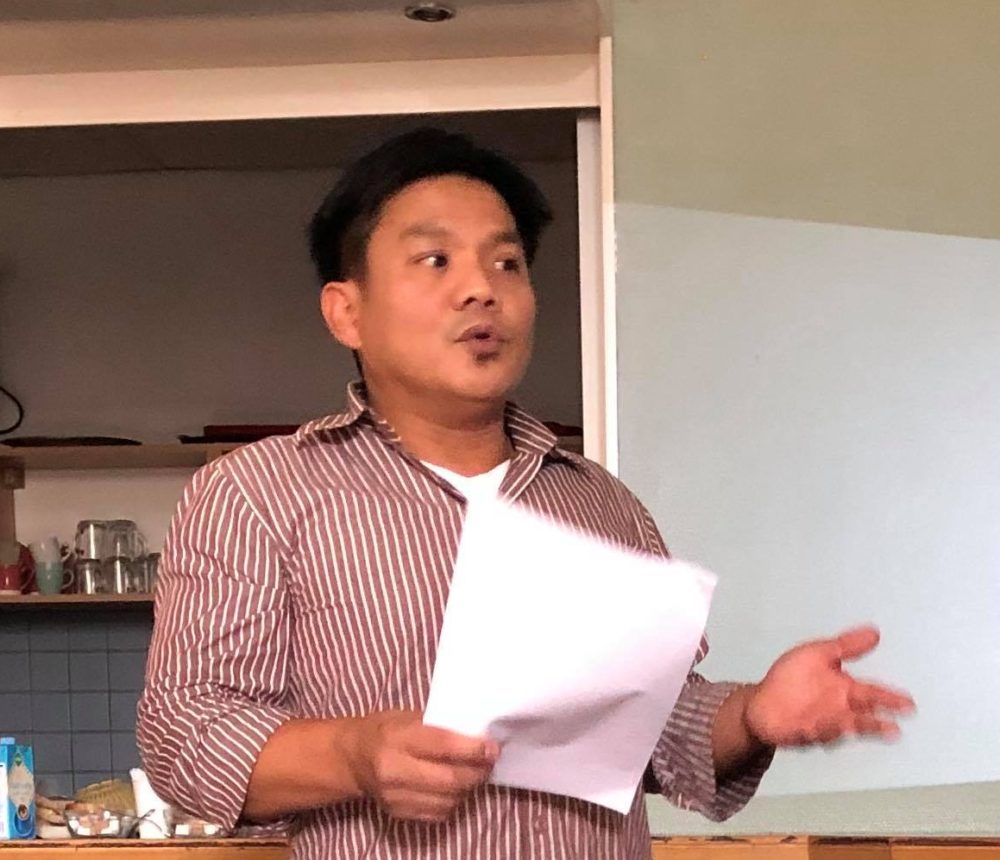
Andrei Angnged is a holder of a degree of Bachelor of Arts in Anthropology and History from the University of the Philippines Baguio and Master of Science in Social and Cultural Anthropology at Vrije Universiteit Amsterdam. He worked with NOVIB for around three years until he decided to be a full time father to his two daughters. He and his family live in Groningen, The Netherlands.
